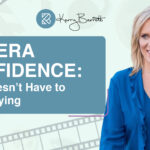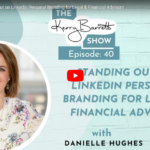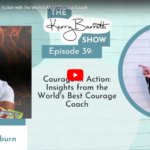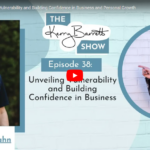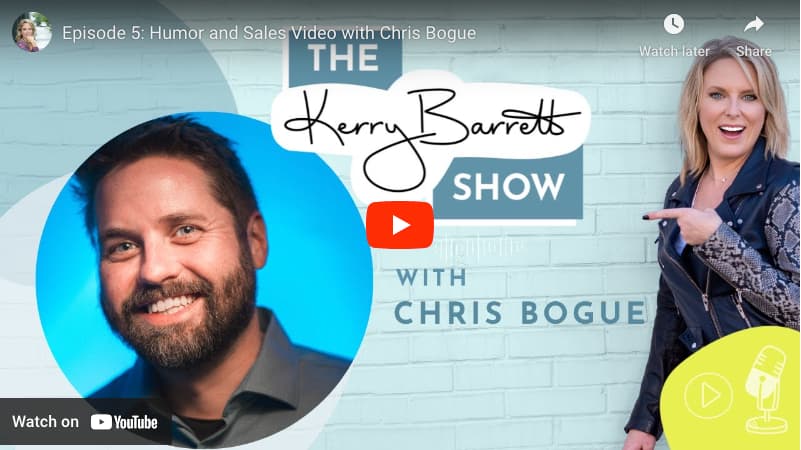
The Kerry Barrett Show with Chris Bogue- Humor and Sales Video Chris Bogue coaches people to create mercifully short video content for business. He is the creator of the Complete Guide to Selling on Video, a digital course on video prospecting for sales. He is also a sketch comedy writer and host of Chris Sells His Soul on LinkedIn Live. Join Kerry Barrett as she and Chris talk about Humor and Sales Video.
Transcript
Kerry: Joining us on this episode is Chris Bogue. He is a video coach, he is a sketch comedian, and he is the creator of the Complete Guide to Selling on Video. Chris, I’m super excited to talk to you. Thank you for being here.
Chris Bogue: Thanks for having me, Kerry.
Kerry: So, to be honest with our viewers, this is the first time that you and I have ever actually had like a one-on-one conversation, but I’ve been fangirling over your content for a long time now.
And it’s because you talk about things on LinkedIn that not very many other people do.
I want to dive into, in this episode, because we’re going to have you on for two, the element of humor and its use in a presentation, its use in video, and heck, even it’s used in sales. And the reason that this is particularly interesting to me is while I think I have a fairly well-developed sense of humor after spending so much time in the news business, sometimes it’s a little bit twisted, but one of the very first questions I got from a client way back when I first started my business was, how do you incorporate humor into video? If you’re not naturally humorous, why is it important? Basically, all the things that I just iterated to you.
So let’s start with, why humor is important in any sort of video content that you’re creating, a presentation that you’re giving, like sketch comedy is your background. So I know you know this.
Chris Bogue: Yeah, it’s flashy, it gets attention, but most importantly, humor is a form of empathy. So I was trained at Chicago’s Second City which is like a very specific approach to satire. It hasn’t really changed much since the 1950s. But the whole, philosophy of humor at Second City is that comedy is just the truth.
You are taught to play from a point of honesty, and I think people get in their heads that, they think humor needs to be shocking, or they feel like humor needs to be mean-spirited, it needs to be putting someone down, and I really try not to do that. I really try to do stuff that everyone can find fun.
My comedy heroes were always guys like… Chris Farley or John Candy, these real big-hearted guys who just make you smile. And yeah, once you start doing comedy at Second City, you realize that a lot of the best characters on Saturday Night Live were just someone doing an impression of their dad.
They’re not thinking like, what’s the absolute funniest thing I could say right now? They’re thinking like, what would my dad say in this situation?
And because it comes from a place of truth, the audience laughs, because they see themselves in that. And whenever I have to teach a corporate workshop on improv, or any workshop on improv, especially if people are new, the first thing I do is I go, okay, everybody, let’s take a deep breath in.
And now let’s breathe out the need to be funny. Let’s breathe out the need to impress people. It’s this counterintuitive thing where when you tell somebody, that you’re going to tell them the funniest joke on earth, you get this kind of we’ll see about that kind of feeling.
And they’re less likely to laugh as opposed to if you say something off the cuff, that’s just a little bit more honest than they expect, that’s what gets the laugh out of people.
And yeah, once you realize that, and once you get into a space where you’re trying to say the most honest thing, rather than the thing you most think is gonna maybe it’s a joke you’ve heard somebody else say before.
You stop thinking of, like, how can I make the audience laugh? And just, like, how can I say the thing that is just pure honesty? Suddenly you don’t have to think as hard about it.
Kerry: Yeah, you’re not trying to be funny. It’s just whatever the thing is, that’s like funny or true or whatever, but you’re not like, man, I get to go on and put like a massive display on, even though I’m not funny at all, and by the way, that’s a sure way. I imagine just letting the room wither beneath you.
Chris Bogue: Yeah, and you did this thing, so the audience wasn’t watching us in the studio before this episode started, but you had this wonderful little moment yourself, Kerry. Where you’re sitting there and you’re explaining to me how the podcast works, and then all of a sudden you hear your kid off the screen and you turn into the mom for a second.
Kerry: Yeah.
Chris Bogue: And you’re like, and it’s just like that moment was so funny because that’s really you. That’s really you. And if anybody had been watching that, anybody with kids would have laughed because they go oh, that is exactly what happens with my kids.
And you realize it’s I always say it’s like comedy is a formula. You could think about it as a set-up punchline. If you think back to the old vaudeville days, it was like the comedic voice and the straight man, and it’s always these two forces playing off each other. And if you’re not a really funny person, you might just be the straight man in the equation.
And that’s fine. Oftentimes, I will have a person who is more of a serious person, or a no-nonsense type person. And yeah, we’ll put them into a situation where they are doing something silly, completely seriously.
And it’s funny cause it’s real. And again it’s this weird thing where you have to lean into yourself and be like, who am I naturally, and in your case, it’s sometimes you’re a woman who started a business. Sometimes you’re, the news reporter and you come out, sometimes the mother in you comes out, and sometimes you’re the gal that was friendly in school growing up.
And it’s yeah, you try to lean into these different versions of yourself and the more you can astonish the audience with how unguardedly real you are, like, that’s when the real laughs start happening.
Kerry: You tapped into a couple of things there that I think are really interesting. One is the fact that, and you mentioned this right off the top, it’s like a form of empathy. And it’s a form of connection.
I think I’ve always intuitively, realized at least in my news days that if you can get the audience to smile or to laugh, you have so much more buy-in than if they’re just stoically watching you.
They’re not engaged. Humor in whatever form, if it’s done well, and if you’re not trying too hard, it draws the audience in, it creates a connection, you’re laughing and sharing an experience. So you’re closer, I think, to making that, whatever the goal is making the sale, having them sign up for something, I don’t know, join your email list, whatever the case may be, hire you for the next keynote.
And so that makes sense. The empathy in the connection. Does that also work? I can see clearly how that would work for an audience or an industry that maybe is a little bit more creative, or you can expect the people watching to have, maybe a broader sense of what is, appropriate in the workforce or on a professional presentation.
Does this tactic, I guess for lack of a better word, or this presentation style work for more stoic industries like insurance and finance and those sorts of places as well?
Chris Bogue: Yeah, it’s this funny thing where even stoic people like to laugh. And, my last sales role that I was in, I was selling education software to universities. So everybody I was working with was a Ph.D. And yeah, there’s this misconception that like, once you reach a certain level of elite status or, once your net worth reaches seven figures or something people stop laughing and that’s just not true.
Oftentimes, yeah, that’s where you’ll get the biggest laughs from because like they’re really not expecting it. And, I was always taught at Second City the audience is smarter than you,
Go out there and play to the top of your intelligence. And you’ll be surprised at what people will respond to. And I always tell people, it’s look, I do sketch comedy on LinkedIn in part because nobody else really does.
Kerry: Nobody does it. Yeah.
Chris Bogue: Yeah. But, I explained to them, I’m like, look, LinkedIn is the only platform for adults. It’s a social media platform where you don’t have to compete against teenagers and you don’t have a bunch of anonymous trolls just, trolling people and trying to draw attention to themselves.
So if you talk to your audience like adults, it’s refreshing. For comedy, it really does come down to a formula. And there are a lot of really simple formulas for comedy that have been around forever, that you can introduce into basically any form of communication.
Kerry: I think I know one of the formulas for like your classic sort of ad-lib is, or improv rather is always yes and not using those actual words, but like your commentary. It’s almost like you’re one-upping whatever somebody said before. And that’s what keeps the conversation going.
Like you’re, instead of shutting it down and being like, no I would never do that. You’re like, yes, I would do that but only if, I did it in a pool full of jelly. I don’t know. I’m making it up. You know what I mean? Like you’re adding to the conversation. Is that classic Yes, and… one of the formulas? And what are the others that we should think about?
Chris Bogue: So let’s start with yes and, because it’s the most important, I feel. Yes, and… is the fundamental rule of improv. Once you have had Yes, and… beaten into your head. You can improvise with anybody. Tina Fey is a better improviser than me. She’s top of the top.
But I would not be afraid to step onto a stage with Tina Fey because we would just both Yes, and… each other. And the idea behind Yes, and… is your partner is a genius. Everything your partner says is a gift. Their tone of voice is a gift, what they’re doing with their body is a gift, the specific words they say is a gift, and it’s not yes, but, it’s not no, although, it’s Yes, and…
You have to agree with what they say, and you have to add one thing to it. You have to take it one step further. And ultimately, this is a listening exercise. This is very important in sales because people come in with their own frame of reference. They come in with their own priorities and their own feelings.
And if you can start incorporating the words they said into the story, you’re building the story with them in real-time. And yeah, if somebody at the beginning of a call says to me, I almost got into a car accident. Some idiot almost hit me. If like at the end of the call, I’m like, Oh, by the way, drive safe. There are a lot of nut cases out there. They laugh, even though it’s, that’s not the funniest joke on earth. They laugh because it’s remembering something that they said.
Kerry: Or if you’re like, sorry about that was me. I’m the problem. So whatever, something like that.
Chris Bogue: Yeah. Or, in improv, we’re big on specific phrases because you’re, if you’re doing a long-form improv, which Chicago is famous for, you are getting one word and you’re going for 30 or 40 minutes and you’re building a whole storyline.
You’re building original characters all out of thin air. And so they teach you like, you’re never going to walk into an improv scene and say, I’ll have a drink because that’s not how people talk.
But if you go out there and you say, hey, I’ll have a PBR, that’s very different than going out there and saying, hey I’ll have Johnny Walker Blue On Rocks, versus, hey, I’ll take a Cranberry Martini, please.
Those three different drinks are going to evoke three different images in your head of what this person might be. But if 20 minutes later into the forum I come back out and be like, Another cranberry martini, please. Everybody knows who I am and the audience is going to laugh because that specific phrase is so recognizable. Again, it’s almost like an inside joke you’re creating on the spot.
Kerry: I love that you said that and it’s interesting, I just did a blog post about the importance of adding dialogue to videos. Even if it’s just you. You’re just reenacting something because you can divulge so much more information about one of the characters that’s in your video by replicating their words.
Like did they say, yo bizzo, go make me a sandwich, or did they say, oh, you make the best sandwiches? Can you please go make me like… just the dialogue itself reveals so much about the character and the person. It sounds like what you’re saying. There’s a little bit of, there’s some overlap there.
Chris Bogue: Yeah, or even the difference between being like, oh, now I gotta make lunch for the kids, peanut butter and jelly. Versus, I gotta make lunch for the kids, peanut butter and jelly. No crusts! The audience laughs because they’re like, Ugh, my kid makes me cut the crusts off too. And it’s that, it’s real.
So Yes, and… again, is a gift. It has taken me, over 15 years of doing it, and I finally just feel like I’m starting to get the hang of Yes, and…
Kerry: So we shouldn’t expect to get it right away. We’re gonna need a little practice.
Chris Bogue: Yeah, and it’s one of those things where it’s I worked with coaches, I worked with directors. You have to break down your scenes afterward and analyze what worked and what didn’t work, and the scenes that fail almost always fail because I wasn’t Yes, anding.
The director will be able to look at me and say, hey, you know what? There was this moment where your partner said something to you and she gave you all these wonderful gifts. And I could tell that you were thinking about what you wanted to say because you missed them. You didn’t Yes, and… what she said, you tried to force the scene into a predetermined direction, and it didn’t work.
Whereas she just said, hey, passed the fuel for this chainsaw, and if you had just pretended to hand her a gas can or started like it would have been funnier and you would have been doing something together. And yeah it’s really a listening exercise more than anything. You’re listening for the little, idiosyncrasies in the way they speak or oftentimes in a video, when I’m reviewing it with a client, they’ll send me something that’s five or six minutes long.
And my note will be like, hey, at the 2:17 mark, you had this wonderful little aside, it was this casual little aside. That’s the real person. We’re going to do this video again, and that’s going to be the start of the video, and it’s going to be 45 seconds long, and we’re getting one thing across to them. And again it’s that real, emotion that you didn’t expect, but that we’ve all felt, that’s what the audience is laughing at.
Kerry: I’m realizing so much about overlap with other skills here. You’re talking about listening, it sounds like practicing improv is a great way to practice interviewing as well. Or having a Q&A session because it really teaches you to listen to those little nuggets that you’re not thinking about if you’re thinking about what comes next.
Chris Bogue: Sales too. Sales too.
Kerry: Yeah. How do you apply all of this to sales?
Chris Bogue: If I am in a first call, if I’m like in a discovery call or something for sales, I am trying to say as little as possible 10 minutes. I’m really trying to get the other person to speak. I’m asking insightful questions. I’m asking open-ended questions.
I’m asking them about why they showed up in the first place and what they’re hoping to get out of this meeting, and then 10 minutes later, when I’m taking them through and I’m like, now you just said a minute earlier that your clients, keep on saying this to you yeah, that’s very common.
Here’s why I’m going to show you this next feature, you can tailor the presentation to what they actually want and, sellers will, they’ll go into these meetings with these PowerPoint slide decks with 120 different bullet points in them and like hey, maybe your audience only cares about two or three of those bullet points. That’s fine.
You could have an entire call just about that, but if you’re not listening, if you’re not throwing it back to them, if you’re not, Yes, anding… them and picking up on the specifics of what they’re saying, you might blow past the two points that could have actually sold them. So you could demo them on all these features that they don’t actually have any interest in.
Kerry: Oh, yeah. I want to backtrack a little bit. So we talked about, the Yes, And…, I have a two-part question here. Are there other formulas that work particularly well when you are, on video or, using video for sales or training? Are there other formulas that people should be thinking about incorporating? And then are there tips that you have for them to begin to practice on their own? As you mentioned, you’d go back and look at it with a director or a producer and they would tell you, you missed this man. What were you doing? Like, how does somebody begin to figure this out on their own?
Chris Bogue: Yeah. Getting a coach or taking a course helps. Obviously, we’re both video coaches, so it’s self-serving for me to say that. But there’s a reason why Tina Fey and Amy Poehler all like movies together repeatedly. And it’s because they both trained at Improv Olympic in Chicago together. You see these groups of people who always appear together in movies or always appear together on TV, and it’s usually because they learned together.
And I tell anybody who feels like they’re going through a creative dry spell, or who feels that they have writer’s block, If you take a class, or you’re hanging out with other people who are putting stuff out there, It’s gonna get those creative juices rolling, and you’re probably gonna realize that you’re funnier than you thought you were.
You’ve got more to work on there than you realize. Sometimes it just takes being in a space with other people to get the confidence to just start doing it. And if you want another, simple comedy framework that anybody can do, it’s the rule of threes.
Comedy always comes in threes. I have my own theory about why that is. But there’s something about the rhythm of a list of three, that sets the audience up for an expectation that you can subvert. So if you need an easy joke, if you need to write a joke and you don’t know how to write jokes, include a list of three and you got a serious thing, serious thing, joke.
Hey, it’s Monday here at the sales team, so let’s sync up, let’s hit our 50 dials, and let’s question why the hell we’re doing this. Or, somebody’s oh, what should I bring, you’re like, oh, yeah, you could bring a dessert, you could bring a side, you could bring a bag of rocks for all, it doesn’t even matter, just come.
But you’re setting them up, and yeah, comedy comes in threes, it always has. My theory for that is, thing one is you’re introducing an idea. Thing two, you’re creating a pattern. So the audience starts thinking, Oh, I know where thing number three is going to go. And then you put something silly in there they laugh because they didn’t see it coming.
But that’s a framework. Again, you could do that in speeches. You could do that in emails or internal emails. You give the two things that are serious. Now you’ve got a license for that third thing to throw something silly in there. Again, you’ll start noticing it once you start watching comedies. But yeah that list of three things comes up all the time.
Kerry: And I want to ask you something because as I mentioned, the next episode that comes out of this show will be with you and we’ll be talking about how to use video to sell how to sell on video, video sales etc. My question is this sort of thinking about that, does humor work not just in videos that you may be creating to sell, right?
So you’re on camera and you’re delivering that way. Is it also something that you suggest using, it sounds like I know the answer to this, but just to be clear, you also use this in like personal sort of connections or calls or meetings, or if you’re giving a, I don’t know, like selling from an actual stage somewhere during a speaking engagement, you incorporate these components into all of those different sort of platforms, formats, mediums. Yes?
Chris Bogue: I would actually say not quite.
Kerry: Oh, okay. Then I didn’t understand.
Chris Bogue: I’m using some of these same frameworks, but the goal is not always comedy. I always look at it as What am I doing here? Am I doing one-to-many, or am I doing one-to-one? If I’m doing one too many, that means I’m creating video content. And that means the sky’s the limit. Go be funny, go be interesting, throw cartoons in there, throw music, throw dance, throw, whatever, like the sky’s the limit. I really feel that in sales, people want someone who’s going to talk to them straight.
I don’t perform really, when I am doing my sales videos to prospects, because I don’t want them to feel like they have to perform for me. I am more likely to talk about a joke they made than one that I made. And this goes back to Yes, and the whole idea of Yes, and… is it’s not about you, it’s about everybody, but you.
And, people buy from people they trust, so I’m usually not going to go in there telling a bunch of jokes. More likely if I’m talking about comedy in a video, maybe it’s because somebody who fits my ideal customer profile left a really funny joke on one of my posts.
And I’m just like, hey, Kerry, that was hilarious. That was really funny. And I want to see if you want to talk about getting your team on video, cause it can be really difficult to get started with this. Sometimes people are nervous about what to say. And I come from a comedy background and I get everybody having fun and I get everybody feeling confident. So let me know if you’d be open to a conversation about that.
In sales, especially, I always say even if it’s just me on screen, I think of it as a two-person scene, and the camera is the main character. My, prospect, the buyer, that it is a video about them, and I am just the supporting character.
My job is to make them feel like they’re the funny ones. They’re gonna buy with me if they can visualize their success. I’m just somebody who might have something to offer them in, getting there.
Kerry: Yeah, 100% that makes it makes perfect sense, I did lie, I said that was gonna be my last two questions. I do have one more because you were talking about reaction and that sort of thing. I began to think about spontaneity and its role in being authentic and real and making connections.
And of course, sometimes it elicits laughter. And I thought of it because I’ve had to hone that skill, not in a comedic way, but I’ve had to hone that skill back in my news days or sometimes when hosting shows, even now, because you had to roll with the punches there your guest says something you weren’t expecting and you roll with it.
I did a big keynote for a very stoic insurance association a couple of months ago. And I did a Q&A at the end. And one of them was asking me about the difference unrelated to the keynote about, news and technology now versus what it was like when I first started, which was, I didn’t leave the business all that long ago, but I sure started it a long time ago and they were asking me about the cameras and I was like, yeah, it’s not this anymore. It’s not a small little camera like this.
And I looked around at the stage and there was a stool there and I’m like, it was like this. And I’m like, Oh my gosh, what am I doing? What am I doing? Why am I doing this? But I picked up this giant stool and I put it on my shoulder and I was like, it was like carrying one of these things around all day.
Giant beta cams and it got a laugh. And people talked about it. because it was humor. And not something I’m used to doing very spontaneously in those environments. I was like, Oh, I got to incorporate this into some of the ways that I deliver on an actual stage. All of that to get to the next question.
How do you hone that sense of spontaneity when it comes to humor? Is it applying the formulas that you spoke about? Is it paying attention to what people are saying? Is it using what’s around you? Or am I going, down the wrong path here?
Chris Bogue: So if we’re gonna analyze that bit, there’s a couple of things you did there that made it a successful bit.
Kerry: Okay.
Chris Bogue: One, it goes back to that idea of everything is a gift. When I’m on stage, one of the things I love to do is jump off the stage and walk into the audience. I break that fourth wall because I want to show them, no, this is not the stage up here. This entire room is the stage.
By picking up the stool and using it, in a way that it’s not a stool, you’re subverting audience expectations, right? You had a gift in front of you. You took advantage of the gift in a way that people didn’t expect.
The other thing is, it goes back to the idea that comedy is truth. You picked up that stool and I could see you acted like it was heavier than it actually was because you remember how heavy the camera was and you were faithfully you know, posturing your body as if it actually weighed that.
And anyone in the audience that has ever dealt with one of those cameras laughs because they’re like, yeah, that’s exactly what it was like.
If you want to apply that to a different context again, it always goes back to this idea. That’s what’s real is funny. I told more jokes back when I was cold-calling. Because you tend to deal with angry people that don’t want to talk to you. And one of the easiest tricks I had to get on their good side, was, I’d call somebody up, and I’d be like, oh, hey, Kerry, this is Chris from whatever company.
And you’d be like, Is this a cold call? I hate cold calls. My response would be like, hey, me too. I can’t even believe you picked up. You know, like,
Thanks for making an exception. Would you mind if I told you why I called? And just that act of being like, oh man, I do too. I don’t normally do this, but I’m really glad you made an exception for me. They’ll laugh cause they’re not expecting the other person to be like, oh yeah, cold calling is weird, but it’s real. I’m leaning into what I really believe.
And, again, it’s I’m not thinking of the corporate thing. I’m thinking of what the honest feeling I have here is. Here’s a, here’s another simple one. I’ll give this freebie to anybody who’s nervous about doing sales.
Kerry: Okay.
Chris Bogue: Talk about food. It is such an easy icebreaker because we all have to eat every day. But I would have a little kind of rapport-building moment.
It’s very common if you ask somebody how’s their morning going or how’s their day going. They’re like, ah, it’s okay. How about you?
If somebody throws a bat at you, I always reference food. I would be like, you know what? There’s a stack of donuts in the break room and I’m trying to watch my weight.
So I am trying to resist. But other than that, it’s all right, or Girl Scout Cookies is my other go-to when it’s Girl Scout Cookie season they’d be like, ah, how are you doing today?
And I’m like, ah, I just ate a sleeve of Girl Scout Cookies for breakfast. Make of that what you will. Would you mind if I told you why I’m calling, sometimes they would Yes, and… sometimes they hear that specific phrase. They hear Girl Scout Cookies and they’re like, oh, I love the Thin Mints. And I’m like, Yeah, I’m a do si-dos guy, but respect to the thin mints. And again, it’s like we’re talking about something real. We’re leaning into our real feelings.
That’s where you’re going to have that little moment where they smile. Maybe they recognize something in you that they see in themselves. All of a sudden they realize they’re talking to another person, not just some creep who’s going to try to, strong arm them, or talk to them about a bunch of, numbers that they don’t necessarily believe.
And again, it’s often simpler than what people think. They’re trying to think of the funniest punchline on earth. And I’m like if you just told them what you had for lunch, you might have gotten an unexpected laugh out of them.
Kerry: Yeah, it takes practice to do it really well, but incorporating it in these small doses, you don’t have to try so hard. It’s just, I love what you said. It’s leaning into whatever’s going on and the real thing. And maybe twisting it a little bit or the way that you say it.
And so it brings people in. You’re not talking about whatever it is you’re selling. You’re talking about oh yeah, trying to have a hot girl summer and there’s a stack of whatever sit next to me, that sort of stuff. I love it. Chris, I could really talk about this with you forever.
We are out of time and I’m looking forward to having you on the next episode to talk a little bit deeper in sales. Before we do go, if people are interested in working with you, and seeing more of your content, where would you like to send them? Where should they go?
Chris Bogue: Yeah the easiest way is to follow me on LinkedIn. You can ring the bell. I’m a content creator. I put new video content out there all the time. Much of it is comedic, but also a lot of it is educational about how to get on video, how to sell on video how to create video content that is honest and fun and inviting and educational.
You could also check me out at ChrisBogue. io. That is where I sell my course, The Complete Guide to Selling on Video. That too has a bit of sketch comedy, just to pull you from module to module, but it really is, a guide to how to put video into all stages of your process, and how to get your message short.
How to make sure you’re reaching out to the right people, and how to set up your camera and lights. So you don’t have to worry about your appearance.
How to do subtitles, and how to send on LinkedIn and Gmail. So if you really want to get deep on the video strategy for sales you can check that out at chrisbogue.io.
Kerry: Chris, fantastic. Thank you so much for being here. And, we’ll see in the next episode.Chris Bogue: Thanks for having me.
Connect with Chris
Website: chrisbogue.io
LinkedIn: linkedin.com/in/chris-bogue/Podcast: spotifyanchor-web.app.link/e/ESmeqjLPABb
